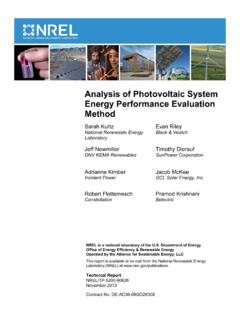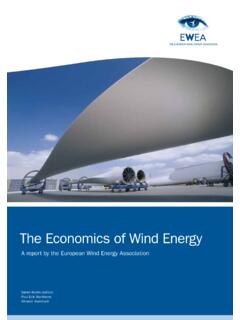Transcription of Carbon-free high-loading silicon anodes enabled by sulfide ...
1 BATTERIESC arbon-free high-loading silicon anodesenabled by sulfide solid electrolytesDarren H. S. Tan1, Yu-Ting Chen1, Hedi Yang1, Wurigumula Bao1, Bhagath Sreenarayanan1,Jean-Marie Doux1, Weikang Li1, Bingyu Lu1, So-Yeon Ham1, Baharak Sayahpour1, Jonathan Scharf1,Erik A. Wu1, Grayson Deysher1, Hyea Eun Han2, Hoe Jin Hah2, Hyeri Jeong2, Jeong Beom Lee2,Zheng Chen1,3,4,5*, Ying Shirley Meng1,4,5*The development of silicon anodes for lithium-ion batteries has been largely impeded by poorinterfacial stability against liquid electrolytes. Here, we enabled the stable operation of a weight %microsilicon anode by using the interface passivating properties of sulfide solid electrolytes. Bulkand surface characterization, and quantification of interfacial components, showed that such anapproach eliminates continuous interfacial growth and irreversible lithium losses. Microsilicon full cellswere assembled and found to achieve high areal current density, wide operating temperature range,and high areal loadings for the different cells.
2 The promising performance can be attributed to boththe desirable interfacial property between microsilicon and sulfide electrolytes and the distinctivechemomechanical behavior of the lithium- silicon (Si), which has a specific capacityexceeding 3500 mAh g 1, has emergedas a promising alternative to graphite-based anodes (with a specific capacityof ~370 mAh g 1)toincreasetheenergydensities of lithium-ion batteries (LIBs), forvarious energy-storage applications such aselectric vehicles and portable devices (1,2).In addition to being the second most abun-dant element in Earth scrust,Siisalsoenviron-mentally benign and exhibits electrochemicalpotentials close to that of graphite ( V versusLi/Li+)(2). However, commercialization of Sianodes is hindered by its poor cycling andshelf life resulting from continuous solid elec-trolyte interphase (SEI) growth between thehighly reactive Li-Si alloy and organic liquidelectrolytes used in LIBs.
3 These deficienciesare exacerbated by the large volumetric ex-pansion (>300%) of Si during lithiation andby the loss of Li+inventory due to SEI growthand irreversibly trapped Li-Si alloy enclosedwithin (3).Current efforts to mitigate capacity fade in-clude the use of sophisticated Si nanostruc-tures in combination with carbon compositesand robust binder matrix to mitigate pulver-ization (1,3 6). Liquid electrolyte modifications,including the use of cyclic ethers, fluorinatedadditives, or other ionic liquids additives thatstabilize the SEI, have also been explored (5,7).Improvements have been reported in numer-ous half-cell studies, but the varied amountsof lithium excess make it challenging to eval-uate the effectiveness of each strategy. Amongreports that demonstrated stable cycling infull cells (5,8 20), most are limited to 100 cy-cles, apart from a few that demonstrated longercycle life using various prelithiation strategiesto compensate for Li+inventory losses (9,14,18).
4 Although prelithiation can be effective to ex-tend cycle life, the ideal Si anode should becomposed of pristine microsilicon (mSi) par-ticles that do not require further treatment,reaping the benefits of low costs, ambient airstability, and environmentally benign proper-ties. To realize this potential, two key chal-lenges should be addressed: (i) stabilizing theLi-Si | electrolyte interface to prevent continu-ous SEI growth and trapped Li-Si accumulation,and (ii) mitigating growth of new interfacesinduced by volume expansion that results inLi+ stability problems arise mainly from theinterface with liquid electrolytes. The use ofsolid-state electrolytes (SSEs) in an all solid-state battery (ASSB) is a promising alternativeapproach, owing to its ability to form a stableand passivating SEI (21). Previous studies havereported the use of thin (submicrometer) filmtype Si in ASSBs (11,22,23). Most ASSB reportshave focused on the use of metallic Li, in aneffort to maximize cell energy densities (24,25).
5 However, small critical current densities ofmetallic Li anodes often dictate the need foroperation under elevated temperatures, es-pecially during cell charging. In this work, amSi electrode consisting of wt %mSi isused inmSi||SSE||lithium nickel cobalt man-ganese oxide (NCM811) cells to overcome boththe interfacial stability challenges ofmSi andthe current density limitations of conventional liquid-cell architec-tures, the SSE does not permeate through theporousmSi electrode (Fig. 1), and the inter-facial contact area between the SSE and themSi electrode is reduced to a two-dimensional(2D) plane. After lithiation ofmSi, the 2D planeis retained despite volume expansion, pre-venting the generation of new exhibits an electronic conductivity of~3 10 5 Scm 1(fig. S1), comparable to thatof most common cathode materials (~10 6toRESEARCHT anet al.,Science373, 1494 1499 (2021)24 September 20211of61 Department of NanoEngineering, University of CaliforniaSan Diego, La Jolla, CA 92093, Energy Solution,Ltd.)
6 , LG Science Park, Magokjungang 10-ro, Gangseo-gu, Seoul07796, of Chemical Engineering, Universityof California San Diego, La Jolla, CA 92093, and Energy Center (SPEC), University of CaliforniaSan Diego, La Jolla, CA 92093, of MaterialsScience and Engineering, University of California San Diego,La Jolla, CA 92093, USA.*Corresponding author. Email: ( )CathodeCarbonSSE SiPassivating Si AlCuSEILi+Li+Li+SEI FormationLi-SiLi-SiSEISEILi+Li+Li+Li+Li+ Li+Lithiation of Si,Li + Si Li-SiExpansion &DensificationLithiation StepFig. 1. Schematic of wt %mSi electrode in an ASSB full lithiation, a passivating SEI is formed between themSi and the SSE, followed by lithiationofmSi particles near the interface. The highly reactive Li-Si then reacts with Si particles within its vicinity. The reaction propagates throughout theelectrode, forminga densified Li-Si from at University of California San Diego on September 23, 202110 4 Scm 1)(26 28), so additional carbon ad-ditives are not necessary.
7 Moreover, carbon iswell known to be detrimental to the stabilityof sulfide SSEs, as it promotes SSE decom-position (29,30). Although certain types ofcarbon have been found to be compatible withanode-free ASSBs (24,31), eliminating carbonentirely in themSi ASSB system is lithiation ofmSi, Li-Si formation canpropagate throughout the electrode, benefit-ing from the direct ionic and electronic con-tact between Li-Si andmSi particles (Fig. 1).This process was found to be highly revers-ible without the need for any lithium full-cell experiments were performed,achieving current densities up to 5 mA cm 2,operation between 20 and 80 C, and arealcapacities of up to 11 mAh cm 2(2890 mAh g 1)for the different cells. Subsequent cycling ofthemSi-NCM811 full cell at 5 mA cm 2wasfound to deliver a capacity retention of 80%after 500 cycles, demonstrating the overallrobustness ofmSi enabled by characterizationTo demonstrate the importance of eliminatingcarbon in the anode, as well as the passivatingnature of the Si-SSE interface, we character-ized and quantified the SEI products from SSEdecomposition with and without the presenceof carbon additives.
8 As most literature reportsadopt Si composites containing between 20 and40 wt % carbon additives (5,8 20), this wasused as a basis for comparison against carbon-freemSi. Although Li metal is typically usedas the counterelectrode in liquid electrolytestudies, its low critical current density in ASSB smake it unsuitable for studying our system(32,33). Likewise, limited kinetics in lithiumindium alloys also make them inappropriate(fig. S2). Thus, NCM811, which is protectedby a boron-based coating (34), was insteadchosen as the counterelectrode, allowing di-rect evaluation ofmSi in a full cell configura-tion without lithium excess. To prepare thesamples, we used two composite Si-SSE an-odes (with and without 20 wt % carbon ad-ditives). Composite anodes with SSEs wereused to exaggerate any interfacial reactionsfor characterization. Figure 2A shows thevoltage profiles of both cells during the firstlithiation.
9 The cell without carbon shows aninitial voltage plateau around V, typicalof amSi||NCM811 full cell. However, the cellwith 20 wt % carbon shows a stark difference,with a lower initial plateau at V, indicatingextensive SSE electrochemical decompositionbefore reaching the lithiation potential V. Figure 2B compares the diffraction pat-terns of the pristine Si-SSE, lithiated Si-SSE,and lithiated Si-SSE-carbon composites. Thelithiated Si-SSE sample retained the crystallineTanet al.,Science373, 1494 1499 (2021)24 September 20212of6 Fig. 2. Carbon effects on SSE decomposition.(A) Voltage profiles ofmSi || SSE || NCM811 cells with and without carbon additives (20 wt %). Inset shows a lowerinitial plateau indicating SSE decomposition. (B) XRD patterns, and (CtoE) XPS spectra of the (C) S 2p, (D) Li 1s, and (E) Si 2p core |RESEARCH ARTICLED ownloaded from at University of California San Diego on September 23, 2021structure of the SSE as well as that of theunreacted Si, with some signals of amorphousLi-Si manifesting as a hump at around 20.
10 Al-though some SEI is expected, the low amountformed at the interface is most likely notdetectable with this bulk technique. How-ever, in the cell where carbon is used, most ofthe pristine SSE s diffraction signals are nolonger present, indicating severe electrolytedecomposition. During this process, nanocrys-talline Li2S forms as a major decompositionproduct and is observed as broad peaks ap-pearingat2qangles of around 26 , 45 , and 52 .These observations agree with the x-rayphotoelectron spectroscopy (XPS) analysis inFig. 2C, where the presence of carbon resultsin a greater extent of SSE decomposition, asseen by the formation of Li2S(161eV)intheS2p region. Consequently, a larger decrease inpeak intensities for the PS43 thiophosphateunitsignalsisobservedforthe electrodecon-taining carbon (Fig. 2C, bottom) comparedto the electrode without carbon (Fig. 2C mid-dle). Although the Li 1s region (Fig.)





